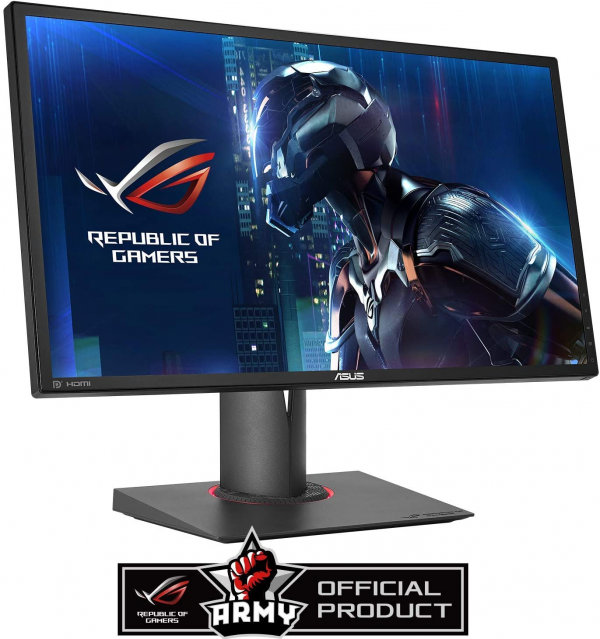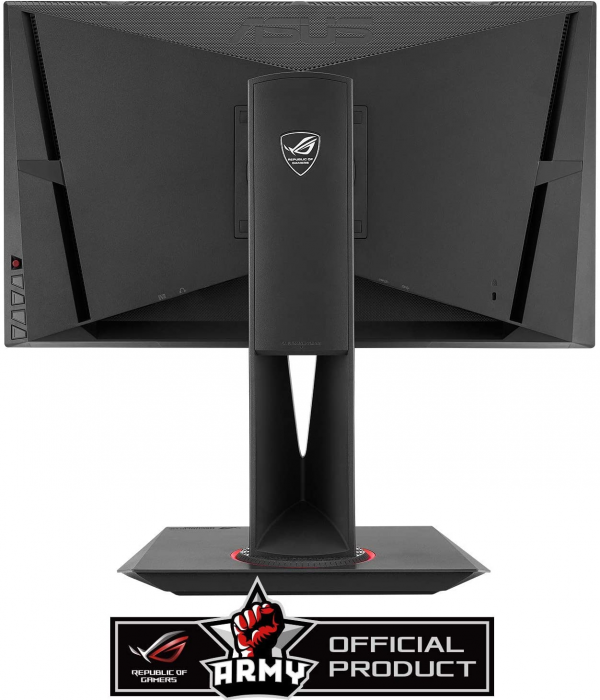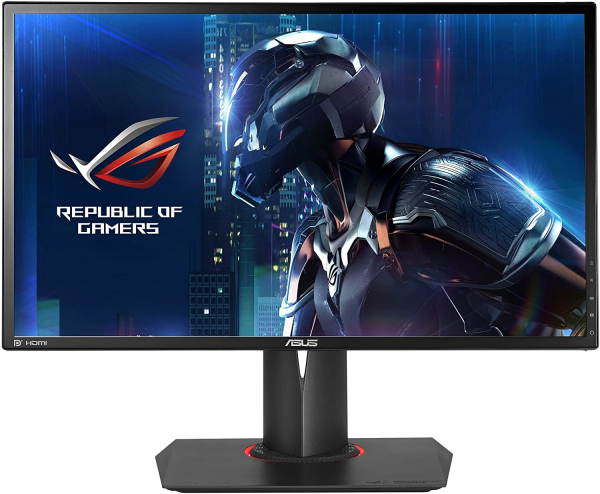Asus
Asus PG248Q: the small 24 inch monitor from the ROG range
Aprox. 755€ - see price -
See specificationsThe PG248Q monitor takes the recipe from Asus that works on its 27 and 34 inch models and applies it to a smaller model, only 24 inches.
Positive points
Finish.
Reactivity.
Different foot settings.
OSD still just as enjoyable.
Frequency of 144 Hz (180 Hz in G-Sync).
G-Sync compatible.
Bad points
Disappointing contrast.
Image rendering before adjustment.
Limited viewing angles.
Our review
Presentation
The ROG Swift PG248Q monitor is the smallest in the Republic of Gamer range from Asus. It has a 24 inch TN panel displaying a Full HD definition of 1920 x 1080 px. This monitor is compatible with G-Sync technology which allows you to adapt the screen refresh rate to the number of images sent by the graphics card, between 30 and 180 Hz. Natively, the frequency can go up to 144 Hz, but using G- Sync with a compatible GeForce graphics card allows the frequency to be pushed to 180 Hz. The monitor is also compatible with Nvidia's 3D Vision 2 technology and backlight scanning (ULMB). In terms of ergonomics, we find the small refinements that have made the reputation of the ROG range, with an adjustable foot in all directions, almost complete connectivity, a USB hub and the joystick giving very easy access to the settings.
The Asus PG248Q monitor is sold for around € 500. In comparison, the Asus PG278Q, also equipped with a TN 144 Hz panel but in 27 inch QHD, is sold for just under € 700.

Ergonomics
As on the PG279Q and PG27AQ monitors, the gamer design is asserted, but compared to those of other manufacturers, the Asus screens are relatively discreet. The anthracite gray is sober and only the beveled foot with its luminous red halo translates the gamer side. The screen edges are quite thin and, above all, the coating of the screen is matt.
The imposing foot is adjustable in height by 12 cm. The inclination is adjustable between -5 ° and + 20 °. The panel also switches to portrait mode (pivot) and the stand is rotatable ± 50 °. As always with ROG monitors, the various adjustments are made smoothly, without any noise; a guarantee of quality.
Finally, the rear of the monitor cuts even more than the front with protruding edges reminiscent of those on the stand. The connectors are located under the screen and the opening at the base of the stand serves as a cable management system.
The connection is rather light, a characteristic common to all G-Sync screens. There is simply an HDMI 1.4 input, a DisplayPort input, the only one capable of handling Full HD definition at 180 Hz, two USB 3.0 ports and a headphone output. The screen also has two 2-watt speakers whose quality is very average. They are just enough to restore the voices and will only be used to troubleshoot.
The four buttons on the side allow you to turn on the monitor and access the various shortcuts. The joystick allows you to navigate the OSD settings very intuitively. To date, this is still the best system for accessing the various settings. And there are many: brightness, contrast, temperature, saturation, overdrive, blue light filter, source, position of the OSD, overclocking of the refresh rate, etc. The Light In Motion menu allows you to manage the light emitted by the foot ring and it is also possible to display a timer or viewfinder superimposed.
By lowering the brightness to 31 to obtain a white at 150 cd / m², the Asus ROG PG248Q monitor consumes 25 watts, ie a relative consumption which reaches 120 W / m², higher than the average of monitors (100 W / m²).

Colors and contrast
Default: average gray temperature: 7,040 K
Default: gamma curve at 1.9
Default: Delta E average at 4.2
By default, the Asus PG248Q monitor denotes a bit of its big brothers, the PG279Q and PG348Q, whose rendering was perfect. It is clear that this is not the case here. Delta E - difference between the colors requested and the colors displayed - measured at 4.2 results in a slight drift of green and red (the eye no longer makes the difference below a Delta E of 3) then that the gamma - even if fairly stable - is established at 1.9 and therefore quite far from the expected 2.2. The temperature is not free from faults either, with an average of 7,040 K and a curve that is not really linear.
Manual adjustment: average gray temperature: 6,800 K
Manual adjustment: gamma curve at 2.0
Manual setting: Delta E medium at 2.9
After reducing the brightness to 31 to obtain a white close to 150 cd / m², we set the temperature to Warm in order to get closer to the reference value (6500 K). If the temperature curve remains the same, the average drops to 6830 K. The gamma goes up a little (2.0) and the colors can now be considered to be faithful (average Delta E at 2.9).
Calibrated: average gray temperature: 6.830 K
Calibrated: gamma curve at 2.2
Calibrated: Delta E medium at 1.4
The calibration of the monitor with an ICC profile is saving since the temperature and gamma curves are perfectly stable. The average gamma is perfect (2.2) while the temperature remains at 6830 K. The colors can now be considered perfect with an average delta E at 1.4. The rendering is perfect. This color profile is available on Focus Numérique.
The TN panel clearly sins by its lack of contrast: it does not exceed 800: 1, while some TN monitors approach the 1000: 1. In all cases, this remains very far from the contrast offered by VA panels, whose best representatives (Eizo Fortis FG2421 and BenQ BL2410PT) exceed 3000: 1, but it is also disappointing for a TN panel, especially at this price.
The average difference in uniformity is only 6% over the entire 24-inch panel and we did not find any light leaks or clouding. Unfortunately, the viewing angles are not flattering: we can for example observe a vertical gradient on a background that should be solid.

Reactivity
The Asus ROG PG248Q does not use Pulse Width Modulation (PWM) to adjust the power of the backlight, and therefore the brightness. This modulation usually varies the intensity of the LEDs cyclically; a phenomenon that is perceived as flicker by some sensitive people. In some rare cases, this modulation can induce eyestrain and headaches. So there is no such problem with this monitor.
By default, the overdrive is set to Normal, which allows a remanence time of only 5 ms, without ghosting effect. Switching to the Extreme setting results in the appearance of a reverse ghosting phenomenon (a negative trail appears behind a moving object). We therefore prefer the Normal setting, which already offers satisfactory performance. We measured the delay in display (input lag) at 13.5 ms. There is almost no lag between the source and the monitor, but this model does slightly worse than its big brothers, which did not exceed 10 ms.
Backlight scanning is very effective and improves the sharpness of moving objects, but it only works with a refresh rate set to 120 Hz and by disabling G-Sync mode. You will have to choose one or the other.

Conclusion
The Asus PG248Q monitor is a small step below its big brothers, the PG279Q and PG348Q. It even does a little worse than the Asus PG278Q, still in the catalog, and not that far apart in terms of price. The Asus PG248Q is nonetheless a good gaming monitor, with a native frequency of 144 Hz, G-Sync compatibility, one of the best responsiveness on the market, proven ergonomics and a quality finish.

Specifications

